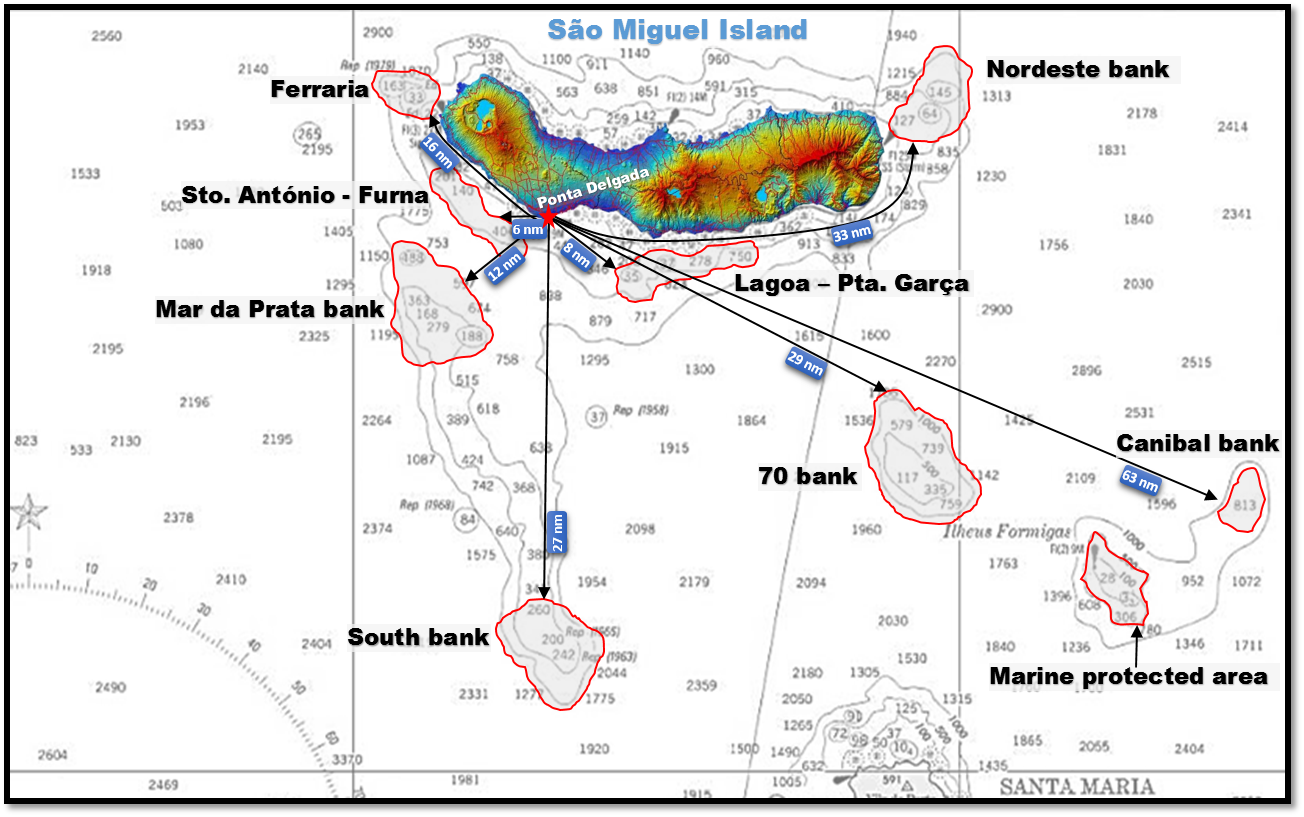Fishing
The Azores are an important destination for many migratory pelagic species that make seasonal migrations of thousands of miles across the Atlantic Ocean. Local coastlines and numerous submarine banks hold huge quantities of bait – a vital food source that attracts and sustains so many large pelagic fish during their migration.
Species and seasons
| Marlin
Marlin season is from mid July to early October when the sea water temperatures are at their highest. There may still be plenty of big pelagic fish to target throughout October, but the deterioration of weather conditions during this period tends reduces the number of fishing days. Blue marlin Blue marlin usually appears in the Azores when the temperature of the water is 22⁰ C. Although most fish average around 500 lbs there is always the chance to see a fish of 1000 lbs+ which is known as a ‘grander’. The biggest we caught had 970 lbs. In 2009, we caught and released 5 blue marlin in single day and every year, there are usually some days that we catch 3 or 4. White marlin White marlin can be very abundant in Azores. They usually appear a little earlier than blue marlin, presumably because they can support slightly lower water temperatures. They are impressive fighters with light tackle rods and usually weigh around 50lbs. In 2008, we caught 4 at the same time. Other billfish, like spearfish, are less abundant, but they can appear during the marlin season. Swordfish Although they can be abundant, swordfish are not usually caught by sport fishermen. They of more importance to commercial fishermen who usually catch them at night and rarely during the day. Commercial fishermen are known to occasionally catch large specimens with more than 600 lbs.
Tunas High season for tuna is usually from mid-April to the end of June but they can also appear at other times of the year. During the last years, the tuna season has extended well into the summer months and has been particularly good around the end of September. Bluefin tuna This super strong and highly migratory fish is also frequently seen and occasionally captured in the Azores. Their presence is more difficult to detect because they spend a lot of time in deep water. They are often seen during the winter months when the water temperatures are a colder 15-16º C. In 2014, we caught and released several bluefins around 500 pounds each. Bigeye Tuna Bigeyes can be very abundant in the Azores and are very important for the regional economy. They normally weigh between 130 to 170 lbs, but some fish may be more than 300 lbs especially in recent years. In 2016, we caught 34 in a single day, with largest weighing 314 lbs. Other tunas, like albacore and skipjack tuna are also common in the Azores. Albacore, typically weigh in at around 45 lbs. In 2008, we caught 18 in single day. Skipjack tuna are smaller and usually weigh around 10 lbs. The beautiful yellowfin tuna are less common and usually occur when temperatures are higher, typically in August. In 2014, we captured big specimens in which the largest had 295 lbs. |
 Illustrations: Les Gallagher / Fishpics® ImagDOP UAç
|
|
Smaller species such as Dolphinfish (Dorado) and less commonly, Wahoo, are caught from time to time. Sharks such as Mako, Hammerhead and Blue are common in our waters and quite easy to catch. These days, they have become less popular amongst big-game fishermen. Coastal/bottom fishing for Barracudas, Atlantic bonito, Bluefish, Jacks, Mackerel, Grouper, seabreams, and trigger fish, can be good throughout the year.
Fishing areas and spotsOnce the Azores have a volcanic origin, in just a few miles from the coast we have numerous submarine banks that rise from the very deep seafloor (> 1000 meters) surrounding the islands. Therefore, excellent fishing areas can be reached within 20 minutes from the harbor maximizing the fishing time and the possibility of catching fish.
Research and sustainabilityWe fish according to IGFA regulations and ‘tag and release’ all marlin in accordance with the Billfish Foundation, except in the case of potential world records or 1000 lbs+ fish. All other types of fish such as tunas or coastal fish usually are landed, but under your desire and/or scientific studies, we release it. Can be important to know that in the Azores the sport fishing boats cannot sell their catch in the market so, we only land the fish needed to share with you, our family and friends, allowing us to enjoy seafood in a sustainable way. As catch and release fishing techniques are the best way to quickly release a fish with minimum stress experienced, it is our pleasure to collaborate in any national or international research programs for the study of large pelagic fish species such as those found in the Azores. Scientific or student members are invited to join us during our fishing operations, although their presence will have to be agreed prior with the clients. By keeping this interest in sharing our knowledge with the scientific community, we aim to contribute for better sustainable management of our marine environment to ensure that future generations are able to enjoy the unique resources we have. Just for interest, although the Atlantic blue marlin and the bluefin tuna are listed as a threatened species by the IUCN, a number of studies have shown that ‘tag and release’ fishing may cause minimal catch mortality of < 10%, supporting the sustainability of these top marine pelagic predators. |
|









